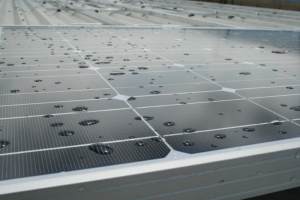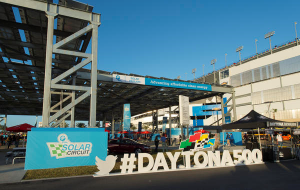Vol. 18 #2 May 25, 2017: Community Storage
In This Issue
Flanigan’s Eco-Logic
Paris Agreement Signed
Community Solar Updates
Re-purposing a Block in Oakland
Iran, Denmark Co-op in Renewables
Chernobyl at 30
Rail Energy Storage
Promoting EVs in San Diego
Turning Raindrops into Electricity
Daytona: Solar in Sports
eTrees

Flanigan’s Eco-Logic: Community Storage
The great new storage frontier! Since EcoMotion’s white paper on storage titled “The Lithium-Ion Revolution,” there’s been lots going on in this space for us. EcoMotion is now involved with a project using flow batteries on six school campuses in Monterey, able to provide emergency backup for seven hours, plus demand-limiting/peak shaving, energy arbitrage, and ISO services to boot… with solar! Stay tuned for EcoMotion’s upcoming white paper on “Distributed Storage and Ancillary Services.”
Now we add perspectives on storage, beginning with a new and very basic form of storage. Imagine pulling a train up high on a hill, having it sit patiently, and then letting it roll downhill during peak periods. It generates power through regenerative braking. And how about community storage, a parallel to community solar?
Throughout the course of civilization, no doubt, humans, like squirrels and bears, store provisions… be it gunpowder, pork, squash, tea, or wine. I have two friends who pay for community wine storage. Thankfully, they keep a nice inventory on hand and in perfect climate-controlled condition. It must be cost-effective… at least it tastes so!
Community storage? What? Sounds like you pay a monthly fee and get a 10*10 storage locker. But what about the “community” in “community storage?” Don’t we really mean “community energy storage,” or “community electricity storage?” What’s that all about? A place to store electrons?
Community storage builds on the notion of distributed energy storage. It brings in the element of community resources that can be shared and that provide value to the grid. Just as community solar provides a new path for solar deployment in our communities, community storage is a new and potentially disruptive way for consumers to trade in the grid of the future.
A Rocky Mountain Institute paper provides insights on how existing resources can be used as storage. In our homes, we store energy in the form of hot water, heat, cool air, some of which can be cycled and is thus a “resource” to the grid when needed. These storage opportunities are numerous and can scale quickly.
Electric vehicles have game-changing potential for community energy storage. Imagine if all EVs not in use are plugged into the grid, equipped with two-way capability. When the grid needs resources… be it capacity or frequency regulation, voltage support, etc… these “community resources” will be on call to discharge.
And community storage could work in other ways. Just as community solar arrays are being developed for community solar, large storage systems may be developed by third parties, like data centers, with their capacities sold in subscriber models. This might be an ideal way for apartment and condo owners, and homeowners who are cannot install storage at their own locations, and who have no other means of controlling their time of use, to share in a community system that provides benefits to all.
The great new storage frontier! Since EcoMotion’s white paper on storage titled “The Lithium-Ion Revolution,” there’s been lots going on in this space for us. EcoMotion is now involved with a project using flow batteries on six school campuses in Monterey, able to provide emergency backup for seven hours, plus demand-limiting/peak shaving, energy arbitrage, and ISO services to boot… with solar! Stay tuned for EcoMotion’s upcoming white paper on “Distributed Storage and Ancillary Services.”
Now we add perspectives on storage, beginning with a new and very basic form of storage. Imagine pulling a train up high on a hill, having it sit patiently, and then letting it roll downhill during peak periods. It generates power through regenerative braking. And how about community storage, a parallel to community solar?
Throughout the course of civilization, no doubt, humans, like squirrels and bears, store provisions… be it gunpowder, pork, squash, tea, or wine. I have two friends who pay for community wine storage. Thankfully, they keep a nice inventory on hand and in perfect climate-controlled condition. It must be cost-effective… at least it tastes so!
Community storage? What? Sounds like you pay a monthly fee and get a 10*10 storage locker. But what about the “community” in “community storage?” Don’t we really mean “community energy storage,” or “community electricity storage?” What’s that all about? A place to store electrons?
Community storage builds on the notion of distributed energy storage. It brings in the element of community resources that can be shared and that provide value to the grid. Just as community solar provides a new path for solar deployment in our communities, community storage is a new and potentially disruptive way for consumers to trade in the grid of the future.
A Rocky Mountain Institute paper provides insights on how existing resources can be used as storage. In our homes, we store energy in the form of hot water, heat, cool air, some of which can be cycled and is thus a “resource” to the grid when needed. These storage opportunities are numerous and can scale quickly.
Electric vehicles have game-changing potential for community energy storage. Imagine if all EVs not in use are plugged into the grid, equipped with two-way capability. When the grid needs resources… be it capacity or frequency regulation, voltage support, etc… these “community resources” will be on call to discharge.
And community storage could work in other ways. Just as community solar arrays are being developed for community solar, large storage systems may be developed by third parties, like data centers, with their capacities sold in subscriber models. This might be an ideal way for apartment and condo owners, and homeowners who are cannot install storage at their own locations, and who have no other means of controlling their time of use, to share in a community system that provides benefits to all.

 On Earth Day, April 22, 2016, 175 countries signed the Paris Agreement on Climate Change at the headquarters of the United Nations in New York. The agreement had been approved by the 196 Parties to the United Nations Framework Convention of the Climate Change (UNFCCC) in COP21 in Paris on Dec. 12, 2015. The agreement will come into force once 55 countries representing at least 55% of global emissions formally join it, a process initially expected to take until 2020.
On Earth Day, April 22, 2016, 175 countries signed the Paris Agreement on Climate Change at the headquarters of the United Nations in New York. The agreement had been approved by the 196 Parties to the United Nations Framework Convention of the Climate Change (UNFCCC) in COP21 in Paris on Dec. 12, 2015. The agreement will come into force once 55 countries representing at least 55% of global emissions formally join it, a process initially expected to take until 2020.





 Chinese scientists have developed a solar cell with an atom-thick graphene layer that harvests energy from raindrops, making photovoltaic systems productive even on rainy days. The new solar cell can be excited by incident light on sunny days and raindrops on rainy days. These “all-weather” solar cells are “triggered” by both rain and sun, described in a paper published in the Angewandte Chemie journal.
Chinese scientists have developed a solar cell with an atom-thick graphene layer that harvests energy from raindrops, making photovoltaic systems productive even on rainy days. The new solar cell can be excited by incident light on sunny days and raindrops on rainy days. These “all-weather” solar cells are “triggered” by both rain and sun, described in a paper published in the Angewandte Chemie journal.